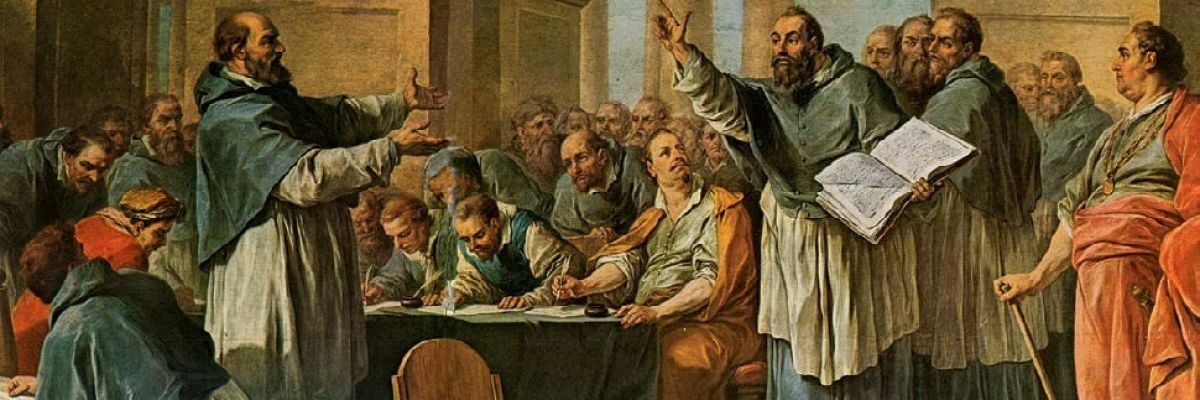
Dates
311-411
Founder
Donatus of Carthage (d. 355)
Background to Controversy
Jesus said, “Those who live by the sword shall die by the sword” (Matt. 26:52). This grim edict is a fitting epitaph for the short-lived but intense heresy of Donatism. Its hundred-year life-span–a rather brief one, as heresies go–was marked from beginning to end with violence and death.
North Africa was roiling in political, social, ethnic, and religious controversies when, in 311, Donatus, schismatic bishop of Carthage, replaced Majorinus, rival of the validly elected bishop Caecilianus. Donatus was a shrewd leader with impressive intellectual and rhetorical abilities. He had a skill for exploiting to his own advantage the ethnic unrest that simmered among the Berbers and Punics. These rustic people chafed under the rule of the Latin-speaking Roman Empire, and Donatus skillfully harnessed their discontent as the engine of growth for his heresy.
The schism had gotten under way before Donatus came to power, but it became identified with him thereafter. His predecessor, Majorinus, was elected as a rival bishop in Carthage because the bishops who had elected Caecilianus had dealt leniently with the traditores, men and women whose faith was compromised during Diocletian’s brief but bloody persecution, initiated in February, 303. The Catholic Church was outlawed, and professing the Catholic faith was a crime punishable by death. Those who refused to offer incense to Roman idols were executed. Churches were razed, relics and sacred vessels were seized, and any copy of Scripture that could be found was burned.
The traditores were those who renounced Christ to avoid martyrdom or who, when their churches and houses were searched by the Roman authorities, handed over sacred artifacts rather than face death. In light of the many who endured martyrdom rather than renounce Christ, those who survived the persecution (which ended in 305) were outraged that priests and deacons who were traditores were allowed to resume their ministry after being reconciled to the Church through confession. This perceived injustice provoked a popular backlash with grave theological implications.
Principal Errors
Majorinus and other leaders of this faction asserted that the sacraments were invalid, even wicked in the eyes of God, if dispensed by a traditor bishop, priest, or deacon. This view expanded to include clergy who were in a state of mortal sin of whatever sort.
By denying the intrinsic efficacy of the sacraments the Donatists claimed the sacraments could be celebrated validly only by those in the state of grace. They required the re-baptism of any Catholic who came over to their sect.
Donatists had the outward forms of Catholicism, including bishops, priests, and deacons, Mass, and the veneration of the relics of martyrs. The heresy of Donatism lay not primarily in the denial of particular Catholic doctrines but in the assertion that only “sinless” men could administer the sacraments validly. The schism was effected by the rejection of the lawful authority of validly-elected Catholic bishops and culminated in illicit but valid ordinations of schismatic bishops, priests, and deacons.
Growth of the Heresy
Donatus advanced his theology with vigor, drawing over many of the common folk who were fed up with Roman imperial rule and who began to equate Catholicism with foreign domination. His organizational skills and charismatic personality attracted huge numbers to his cause. He ordained hundreds, who fanned out across Numidia to establish schismatic churches.
Church historian Frederick van der Meer describes Donatism’s proliferation:
“It was the strangest mixture of African and Numidian particularism, early Christian idealism, and personal resentment, but the Church which it created rose up in every town and locality as a rival to the Church Catholic, altar set against altar in every neighborhood where a Catholic church was to be found. Everywhere at the edges of the ancient towns two great basilicas towered over the houses, one Catholic, one non-Catholic. . . . Donatism was from its inception a popular movement, poor in original ideas, but nevertheless full of people who were easily inflamed and drawing from these its principal strength. Indeed, once the leaders had got the Punic-speaking masses on to their side, no power on earth could heal the schism” (Augustine the Bishop [London: Sheed and Ward, 1961], 80-81).
Donatists adopted “Deo laudes” (“God be praised”) as a their slogan to counter the ancient Catholic “Deo gratias” (“Thanks be to God”). This was the rallying cry with which they harangued Catholics. One distinctive characteristic of the Donatists was their desire for martyrdom. Donatus taught that death for the “cause,” even death by suicide, was holy and merited a martyr’s crown and eternal life. They did their best to incite Catholics and pagans to kill them. When their provocations failed, they sometimes took their own lives, a favored method being to leap from high cliffs with the cry “Deo laudes!”
A humorous if bizarre incident is recounted by Augustine. He tells of a Catholic man who was accosted by a group of zealous Donatists. They threatened to kill him if he refused to “martyr” them. Thinking quickly, he agreed to kill them, but only if they first allowed him to bind them with rope to make his work easier. They consented, and when he had them secured he took a large stick, beat them soundly, and walked away.
In keeping with their penchant for violence there arose among the Donatists a vile faction known as the Circumcellions. These ruffians’ main goal was to harass, despoil, and even kill Catholics. They preyed on the cellae (farms, rural chapels, and country estates). Although Donatus himself was not a Circumcellion, he gave tacit approval to the depredations of these gangs and wielded influence through them to force Catholics to convert to his religion. Those who refused were relieved of their property or their lives.
In a letter to Victorinius, a Spanish priest, Augustine lamented, “We too have nothing but misery here, for instead of the barbarians we have the Circumcellions, and it is an open question which is the worse of the two. They murder and burn everywhere, throw lime and vinegar into the eyes of our priests; only yesterday I heard of forty-eight helpless persons who were compelled to submit to [Donatist] rebaptism in this place” (Letter 111:1-2).
While killing Catholics was a favored pastime, the principal aim of the Circumcellions was the destruction of Catholic churches, Bible manuscripts, and sacred objects. This aroused the ire of the government, which enacted anti-Donatist laws which confiscated their property and forced their re-entry into the Catholic Church. The North African Catholic bishops welcomed the first intervention, but not the second.
Orthodox Response
Originally Augustine opposed the eradication of heresy by force (cf. Letter 23), preferring argumentation to physical coercion. He believed that heresy must never be tolerated, but that heretics themselves must never be forced to join the Church. As time wore on, Augustine’s view changed as he warmed to the idea of the state having a role in the suppression of heresy after the theological persuasions failed. He is regarded by some historians as being the “Father of the Inquisition” since he became a supporter of the state’s right to suppress heresy (cf. Letter 185).
Although Optatus of Milevis was the first notable bishop to write against the Donatists in The Schism of the Donatists, it was the indefatigable Augustine who, in numerous works almost single-handedly demolished the Donatist challenge. He gave a biblical and theological explanation of the sacraments (especially baptism, the Eucharist, and holy orders), of the unity of the Church, and of the evils of schism.
This energetic bishop was not content to rely solely on the pen. He engaged Donatist apologists in public debates, knowing that public disputations would draw crowds of Catholics and Donatists; the Catholics would be strengthened and the Donatists converted. Augustine was as forceful and brilliant an orator (he had received excellent training in rhetoric during his youth) as he was an author, and even the most skilled Donatist spokesmen were no match for him.
He even composed apologetics songs designed to inculcate Catholic doctrine and refute Donatism, notes van der Meer. “Augustine did not neglect to protect his people from the insidious effect of Donatist catchwords, and sometimes to the detriment of good artistic taste. It was probably as early as 393 that he composed an alphabetical psalm against the the Donatist party for the more unlettered among his followers. This tells in very simple verses the story of the origin and development of the schism, its malice, and the only possible cure for it. . . . He wanted the nature of the Donatist issue brought to the knowledge of the simplest person and thus to stamp it into the memory of even the most uneducated” (van der Meer, 104-105).
This hymn was long (293 verses) and employed a melody and poetic meter that was popular among the common people who were accustomed to singing similar songs (with profane lyrics, of course) in taverns and theaters. Catholics learned the hymn enthusiastically and sang it in public as a rebuke to the Donatists. Under Augustine’s aggressive leadership the Catholic Church in North Africa gradually overpowered the Donatists by force of argument. In time entire Donatist congregations and even dioceses came back to the Catholic Church.
By 411 the Donatists were still quite numerous in Numidia and the rest Northern Africa, but, with their theological errors so thoroughly refuted by Augustine, Optatus, and other Catholic apologists, their vigor waned quickly, though it would take two centuries more before they finally disappeared. In keeping with its violent past, the last vestiges of Donatism vanished in the seventh century as its adherents were mowed down by the sword of Islam, the cry of “Deo laudes” being replaced by “Alahu Akbar,” which heralded the Muslim subjugation of North Africa.
Modern Parallels
In its retention of the all of the liturgical externals of Catholicism and most of its doctrines while rejecting a single doctrine or practice, Donatism is mirrored by groups that might be characterized as rigorist. Among similar groups have been the Jansenists of Port Royal (seventeenth through nineteenth centuries) and certain “Traditionalist Catholic” factions of our own time.
The Donatist heresy of rebaptism is alive in the Baptistic churches of Protestantism, although Baptists do not regard baptism as a means of grace and regeneration as the Donatists did. The Donatist tactic of forcing Catholics to “convert” to their heresy was adopted by the Calvinists (especially under John Calvin in Geneva) and most notoriously by the Anglicans (under King Henry VIII, Archbishop Thomas Cranmer, and Queen Elizabeth I).



